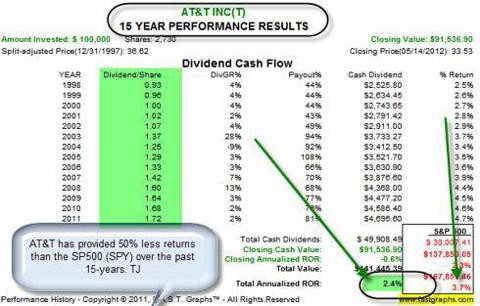How To Use Dividends And Options To Hedge Your Portfolio
Post on: 18 Сентябрь, 2015 No Comment

By Robert Hauver
With the markets violent meanderings these past 2+ months, how to hedge your portfolio has become a burning issue among investors. In this article were going outside of the high dividend stocks world and exploring the hedging potential of two different approaches to fighting market volatility and downturns.
Wouldnt it be helpful to have an inverse vehicle that rises when the market slides, and, like your favorite dividend stocks, pays steady dividends? It seems that some US Treasury Bond ETFs have been doing mostly just that during this bumpy time, and even year to date.
These 3 U.S. Treasury Bond ETFs all pay monthly dividends and have been good hedging tools in 2011:
Profiles (Source iShares website):
TLT: The iShares Barclays 20+ Year Treasury Bond Fund seeks to approximate the total rate of return of the long-term sector of the United States Treasury market as defined by the Barclays Capital U.S. 20+ Year Treasury Bond Index.
IEF: The iShares Barclays 7-10 Year Treasury Bond Fund seeks to approximate the total rate of return of the intermediate-term sector of the United States Treasury market as defined by the Barclays Capital U.S. 7-10 Year Treasury Bond Index.
TIP: The iShares Barclays Treasury Inflation Protected Securities Bond Fund seeks results that correspond generally to the price and yield performance, before fees and expenses, of the inflation-protected sector of the United States Treasury market as defined by the Barclays Capital U.S. Treasury Inflation Protected Securities (TIPS) Index (Series-L).
Moving Averages: These ETFs are all above their moving averages, and very close to their 52-week highs.
So, when should you buy them? If youre bearish, and believe that any rally the market puts together in the near future will only be a short-lived bounce, youd look to buy them on the dip that would most likely happen with a market rally. The stochastic chart below shows overbought and oversold extremes for TLT. Investors who bought TLT in early July would have timed it perfectly, as TLT was oversold at that time. This almost perfect mirror price chart of TLT vs. the S&P illustrates TLTs inverse relationship to the equities market, and how the majority of its gains have come since the summer correction:
(Chart Source: Yahoo Finance)
Technical Data: TLT and IEF have negative betas. and TIP has a very low .10 beta. which is consistent with their use as hedges vs. the S&P. Average True Range is a measure of stock volatility, and is an exponential moving average (14-days) of the True Ranges. The range of a days trading is high minus low, and True Range extends it to yesterdays closing price if that was outside of todays range.
The CBOE Volatility Index, a.k.a. the VIX, or the fear factor, offers an additional portfolio hedging strategy, via trading options. The CBOE defines the VIX as an implied volatility index that measures the market’s expectation of 30-day S&P 500 volatility implicit in the prices of near-term S&P 500 options. The CBOE also states that the VIX has a -0.78 S&P beta correlation. (Source: CBOE)
However, theres a lot of debate about this. As you can see in the table below, the VIX price movement isnt a mirror inverse of the S&P, but has moved in an opposite direction, albeit it more pronounced:
VIX Moving Averages:
A VIX options trade is basically a trade on volatility, which, in general, ramps up during market pullbacks, as investors increase their S&P put purchases in order to protect their portfolios. Given the dramas in DC, Europe, and the Arab spring movement, do you think that heightened volatility will ensue over the next few months? If you do, then selling cash secured puts vs. the VIX is one way to earn some income up front and protect your portfolio from market turmoil. However, this strategy is a bit different than the put options trades youll normally see in our Cash Secured Puts Table .

In the following put option trade, the put bid premium allows you to achieve a break-even near the the 50-day average of the VIX, and potentially earn up to a 16% yield in a little over 2 months.
The Cash Reserve for this trade is $3250.00:
VIX options are European style, meaning that they generally may be exercised only on the Expiration Date. However, you can still buy to close your sold put position at any time prior to the day of exercise .
VIX options generally expire on the third Wednesday of each month. VIX option exercise will result in delivery of cash on the business day following expiration. The exercise-settlement amount is equal to the difference between the exercise-settlement value and the exercise price of the option, multiplied by $100.
The exercise-settlement value for VIX options (Ticker: VRO) shall be a Special Opening Quotation (SOQ) of VIX calculated from the sequence of opening prices of the options used to calculate the index on the settlement date. (Source: CBOE)
In the example above, the VIX price for the morning of 9/9/11 jumped $2.36, to $36.68, (as the S&P dropped 1.37%), which caused this $32.50 put to already fall in value from the $5.20 sale price to $5.00, so it could already be bought to close at a small profit, after one day.
Given the fast ups and downs of the VIX, i.e. the volatility of volatility, your most conservative approach is probably to buy to close any sold position once youve made your targeted profit. This option expires on Nov. 16, 2011.
Disclosure: Author is short VIX puts, and long TLT shares.
Disclaimer: This article is written for informational purposes only and isnt intended as individual investment advice.
© 2011 DeMar Marketing All Rights Reserved.














